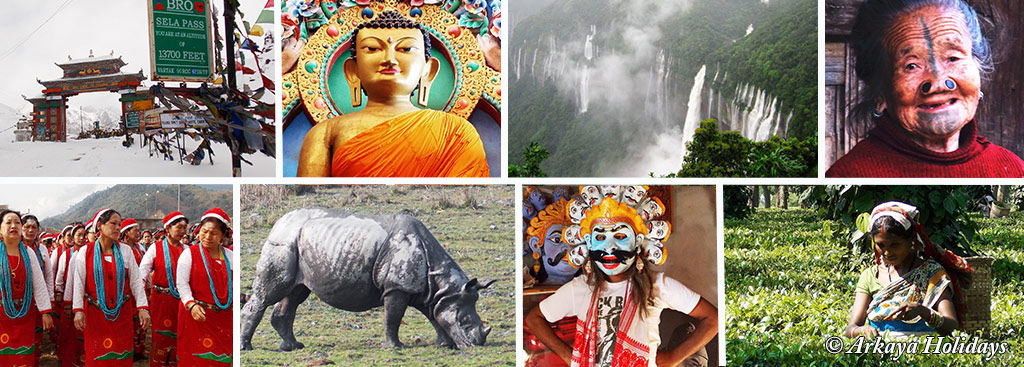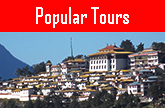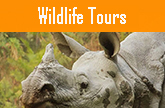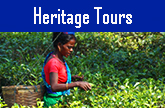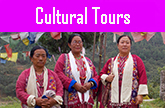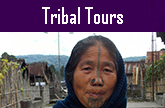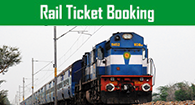North East India Tour
Tour Duration : 34 Nights / 35 Days
Travel Season : October to May
north east india tour itinerary:
Day 01: Arrive Guwahati
Meet upon arrival at Guwahati Airport / Railway Station.
Guwahati:
Guwahati, 'the city of Eastern light' stands on the southern bank of the mighty river Brahmaputra. It is the capital city of Assam and the gateway to the entire north-eastern states. Modern Guwahati is the hub city of Assam. It fulfills every aspect of a metropolitan city with its advanced means of transport, communication and media, as a major center of business activity, educational institutions, and various administrative and political activities of entire Assam. Besides, its landscape surrounded by hills and the mighty Brahmaputra River, rich and diverse flora and fauna enhances its natural scenic beauty.
After arrival, check-in at hotel. Afternoon, visit in Guwahati -
Kamakhya Temple:
Kamakhya Temple, one of the greatest 'Shaktipeeth', the shakti shrine of Goddess Kamakhya is situated on the Nilachal Hills. It is the oldest center of Tantric Shaktism. A famous legend regarding the birth of the Kamakhya temple narrates that Lord Shiva, rage with anger at his wife Sati's death, wandered the entire earth carrying Sati's corpse. An organ of Sati fell here and eventually the place became a temple of worship in due course of time. The temple features various stone inscriptions, terracotta works, sculptures and idols of Ganesha and Chamundeswari which are worth mentioning. The famous 'Ambubachi Fair' is celebrated with great enthusiasm every year in mid-June in this temple and devotees from different parts of India throng into it for the special occasion.
Srimanta Sankardev Kalakshetra:
Sankardev Kalakshetra is named after the most illustrious son and Vaishnavite propagator of Assam. It is the hub of all the cultural activities of entire Assam and a center for the promotion and preservation of the cultural heritage of the various tribes, communities and ethnic groups of Assam. It consists of a museum wherein lies the various traditional dresses, jewelry, ancient pottery, weapons belonging to various ethnic groups, sculpture, and works of art created by various artists depicting as a whole the entire Assam. The open air amphitheatre, wherein the cultural performances are held very often and the collection of whole life activities of the legendary artist Dr. Bhupen Hazarika carry a great measure in Kalakshetra.
If time permits, also visit -
Umananda Temple:
It is a legendary temple of Lord Shiva built by Ahom King Gadadhar Singha in 1664 AD. The temple is standing in an island hill in the middle of great Brahmaputra River. The temple possesses rock-cut figures and sculptures of God Surya, Ganesha, Shiva and Vishnu along with his ten incarnations. The temple is a major centre for the celebration of Shivaratri. The easiest means of transport to this temple is country boat or engine boat which is an added attraction to the tourists.
Overnight: Stay in hotel.
Day 02: Guwahati - Shillong (100 kms, 2 hrs drive)
Meet upon arrival at Guwahati Airport / Railway Station.
Guwahati:
Guwahati, 'the city of Eastern light' stands on the southern bank of the mighty river Brahmaputra. It is the capital city of Assam and the gateway to the entire north-eastern states. Modern Guwahati is the hub city of Assam. It fulfills every aspect of a metropolitan city with its advanced means of transport, communication and media, as a major center of business activity, educational institutions, and various administrative and political activities of entire Assam. Besides, its landscape surrounded by hills and the mighty Brahmaputra River, rich and diverse flora and fauna enhances its natural scenic beauty.
Take transfer to Shillong.
Shillong:
Famously known as the 'Scotland of the East', Shillong the capital city of Meghalaya stands at an altitude of 4908 feet above sea level. The British were so moved by the magnificent beauty of this place that they set it as a Capital city of Eastern Bengal and Assam. Shillong enjoys a serene, pleasant atmosphere with its beautiful lakes, lush green mountains, pine forests and exotic orchids, cascading waterfalls which combine together to make it a finest hill station of north east.
En-route visit -
Barapani (Umiam Lake):
Set amidst the hills of Meghalaya, Barapani is distinctively the biggest artificial lake and the first hydro electric project in the north-east. Wrapped by the rich green valleys and pine trees with the fluffy clouds and blue sky above, the sparkling Umiam lake spreads over an area of 10 sq km. Local folklore narrates of a legend related to the existence of this river stream. As stated, two sisters from heaven planned to make their way to earth, but only one of them reached the destination. At the loss of her sister, the lonely one cried to her heart's lament that her tears created this beautiful lake. Of late, the lake has become a hub for water sports activities like kayaking, water cycling, scooting and boating. The Nehru Park, situated adjacent to the lake, offers a wide collection of orchids and butterflies.
Arrive at Shillong and check-in at hotel. Later, visit -
Don Bosco Centre for Indigenous Culture:
Offering an exclusive display of the heritage and varied unique culture of entire North-East, Don Bosco Centre for Indigenous Culture includes Research on Cultures, Publications, Training, Animation Programmes etc. An indispensable part of this centre, the seven floors Don Bosco Museum exhibits 14 unique galleries displaying a wide range of knowledge interaction on different cultures of North-East India. The Don Bosco Centre for Indigenous Culture skywalk also provides a 360 degree exotic sight of the majestic beauty of Shillong city.
Cathedral of Mary Help of Christian:
The largest and the most beautiful cathedral in Meghalaya, the Cathedral of Mary Help of Christian is the central place of worship of the highest number of Catholics of Shillong. Designed in the pattern of European art and architecture, this religious institution beckons a large number of devotees and tourists to its serene and holistic site.
Shillong Golf Course:
The third oldest Golf course in India, the Shillong Golf Course is famously named as the 'Glen eagle of the East'. It attained its present structure of 18 holes course from 9 holes course in 1924 A.D. by Captain Jackson and C.K. Rhodes. The longest hole on the course, also acclaimed to be the longest in India is the 594 yards, the sixth. Set amidst fragrant pine and flowering rhododendron trees, this golf course offers scenic beauty and calm surroundings with enough space for evening walks and picnics.
Ward's Lake & Botanical Garden:
This artificial horse-shoe shaped lake, locally known as nan-Polok is encompassed by lush green enchanting garden with varieties of colorful flowers, set amidst the heart of Shillong city. A stroll along the sand stone pathways of the garden, pleasant walks on the wooden arched bridge at the middle of the lake and boating in the lotus-filled lake serves as an exciting attraction of this tourist spot. Encompassed by beautifully-laid paved pathways and pleasant atmosphere, the Botanical Garden located near the Ward's lake captures a varied collection of indigenous and exotic plants. In addition, it is a home to a number of rare and colourful species of birds.
Evening: Enjoy shopping at
Police Bazaar:
Try any popular shopping centre like Meghalaya Handlooms & Handicrafts, Purbashree Emporium, Assam Emporium, Khadi Gram Udyog, Grand Bazar, Glory's Plaza, Dedar Market and OB Shopping Mall.
Overnight: Stay in hotel.
Day 03: Shillong - Cherrapunjee - Shillong (60 kms one way, 1 & 1/2 hrs drive)
In the morning after breakfast, take a full day excursion to Cherrapunjee. En-route visit in Shillong -
Shillong Peak:
The highest point in the state, the Shillong Peak showcases a breathtaking view of the city and the surrounding villages around the peak. Set at an altitude of about 6,433 feet, this famous tourist destination is an exciting picnic spot amid scenic and picturesque natural surroundings. The summit of the peak serves as a sacred spot for religious prayers offered to U. Shelling by the spiritual priests of Mylliem Statue during the spring season.
Elephant Falls:
Locally called by the Khasi name as 'Ka Kshaid Lai Pateng Khohsiew' or 'Three Steps Waterfall', Elephant Fall flows through two successive falls set amidst fern covered rocks. The first rays of the sun falling on this cascading waterfall create an eye-catching view to nature lovers especially during the Monsoon season.
Later, drive to Cherrapunjee. En-route stop - Mawkdok Valley View Point.
Cherrapunjee:
Meghalaya is credited to be the home place of the rain capital of the world, Cherrapunjee. Commonly known as Sohra, a trip to this magnificent place enveloped in gushing waterfalls, beautiful valleys, running streams and rivers, unexplored caves creates an everlasting impression in the explorer's mind. The maximum rainfall months are from March to October with an average annual rainfall of about 12,000 mm a year. This place is designated to possess rich tropical vegetation with an eco-friendly atmosphere. A hub of the Khasi culture, it is also famous for orange groves and honey.
In Cherrapunjee, visit -
Arwah Cave:
Arwah cave is comparatively a new tourist attraction in Cherrapunjee. The well maintained wooden trail to the cave from the main road is quite picturesque and its peaceful surrounding offers a close feel to the Mother Nature. Maximum areas inside the cave are well lit. Inside Arwah cave, a stream runs through the center. The limestone caves in Meghalaya are a delight for the people who keep interest in studying the rocks and minerals. Fossils on the rock walls can be spotted easily if observed carefully. (Recommended: Appropriate footwear & flash light)
Mawsmai Cave:
This famous tourist delight is the only fully lighted cave of Meghalaya. Structurally, the cave (with a length of 250 meter) is separated in two parts - old part is entirely lighted while the new part is yet to install such lighting facilities. The cave possesses attractive lime formation of large passages and chambers crafted over years by the slow dripping of water which allows proper space for the tourists to explore around.
Nohkalikai Falls:
Enchanting Nohkalikai Falls is renowned to be the tallest waterfall in India and fourth longest fall in the world with a height of about 1,100 feet. This charming waterfall flowing down to green colored pool holds a tragic legend after its name. As narrated, a local woman named Ka Likai had a daughter from her first husband. She remarries later, but her daughter faces the hatred and jealousy of her step father who strangles her to death and cooks her flesh (in her mother's absence) and offers it to her mother. The heinous act of the father is revealed soon after and in utter grief the woman flung herself off the cliff, thus giving its name 'Nohkalikai', meaning 'fall of Ka Likai' in Khasi language.
Seven Sister Falls:
Popularly known as the Seven Sister Falls, located at Mawsmai village, is claimed to be the fourth highest waterfall in India. The waterfall derives its name from the seven segmented streams which flow down from a height of 1,033 meters. The spectacular sight of the waterfall attracts the tourists only in the rainy season. The other two insignificant names of the Seven Sister Fall are Nohsngithiang Falls and Mawsmai Falls.
Thangkharang Park:
A popular botanical delight housing some rare and exotic orchids along with unique species of plants, Thangkharang park set on rocky cliffs falls under the management and maintenance of the State Forest Department. This park exhibits a majestic view of the plains of Bangladesh on a clear day.
Eco Park:
A large "Eco Park" established by the Meghalaya government in the plateau, which hosts several hybrid and indigenous orchids in the Green House donated by Shillong Agri-Horticultural Society. Also the Eco Park offers breathtaking view of distant Sylhet Plains of neighbouring Bangladesh.
Ka Khoh Ramhah or Motrop:
Ka Khoh Ramhah, also known as Motrop, is an imposing single rock formation in the shape of a giant cone. According to folklore, this was the fossilized cone shaped basket of an evil giant. It lies in close proximity to two other very similar rocks standing like a pair of giant sentinels. During the heavy monsoons, water flows between the two rocks and the cascading waterfall presents a breathtaking sight. The place attracts a lot of visitors throughout the year and is an idyllic picnic spot.
Later, return to Shillong. Evening: Free to explore
Police Bazaar
by your own.
Overnight: Stay in hotel.
Day 04: Shillong - Dawki - Mawlynnong - Shillong (110 kms one way, 2 & 1/2 hrs drive)
In the morning after breakfast, take transfer to Dawki.
Dawki:
Dawki is the border area of India and Bangladesh. Dawki-Tamabil, the road border crossing between India and Bangladesh generally remains open between 6am and 5pm. The border road is used mainly for coal transportation from Meghalaya to Bangladesh. More than 500 trucks cross the border every day during peak season.
Visit at Dawki -
Dawki River:
Dawki River, locally known as Umngot River is the famous venue of annual boat race held during March - April at Umsyiem. Dawki river, the natural boundary between Jaintia Hills with Hima Khyrim of Khasi hills showcases exquisite natural beauty over which only a single span suspension bridge was constructed. (Recommended Activity: Boating)
Dawki Bridge:
Dawki Bridge, constructed by the British during India's pre-independence period in 1932 is a suspension bridge over the Umngot river.
Also visit -
Indo-Bangladesh International Border Maitri Dwar
, a gate of friendship between India and Bangladesh.
Later, return to Mawlynnong village.
Mawlynnong Village:
Popularly known as "God's Own Garden", Mawlynnong Village is famously renowned as the cleanest village in entire Indian subcontinent. The 'Discover India', a travel magazine acclaimed the village as the cleanest in Asia in 2003 and the cleanest in India in 2005. The inhabitants are fully concerned about maintaining the cleanliness of the village. For this purpose, the wastes are disposed in cane basket bins named 'Thapa', placed in every corner of the village. These are gathered in a particular place and later decomposed and used as manure for agriculture. Provision for rainwater harvesting is present in every household. Undisturbed by the hustle and bustle of city life, the conscious villagers preach the motto of conservation and protection of nature. Economy of the village rests on agriculture with a major contribution from the cultivation of betel nuts and broom sticks. Charming flowers blooming amidst spotless clean lanes and smoothly tended garden paths is the eye-catching sight of this magnificent place.
In and around Mawlynnong, visit -
Living Root Bridge:
These exceptional and unique natural bridges are nowhere found in the world except in Meghalaya. Structurally, the roots of the bridges are about 18 inches broad and 6 inches thick. The bridge is engineered from the roots of ficus elastica, a species of the Indian rubber tree with exuberant root growths. The bridges gain their strength with its growing years with a maximum life span of about 500 to 600 years. These botanical wonders serve as a challenge to the human race before the unexplainable mystery of nature. Most of these bridges are still fully functional and are still being used by some villagers as the root bridges are the only nexus between those villages and the outer world.
Also visit -
Natural Balancing Rock, Bangladesh Viewpoint and 100 years old Church in Mawlynnong village.
Later, return to Shillong. Evening: Free to explore
Police Bazaar
by your own.
Overnight: Stay in hotel.
Day 05: Shillong - Badarpur (195 kms, 6 hrs drive)
In the morning after breakfast, take transfer to Badarpur.
Badarpur:
Arrive at Badarpur and check-in at hotel.
Overnight: Stay in hotel.
Day 06: Badarpur - Agartala (265 kms, 8 hrs drive)
In the morning after breakfast, take transfer to Agartala.
Agartala:
Arrive in Agartala and check-in at hotel.
Overnight: Stay in hotel.
Day 07: Agartala
In the morning after breakfast, visit in Agartala -
Ujjayanta Palace:
Kunjaban Palace:
Jagannath Temple:
Indo-Bangla Border Flagoff cermony
Fourteen Goddess Temple:
Overnight: Stay in hotel.
Day 08: Agartala
In the morning after breakfast, visit in Agartala -
Sepahijala Wildlife Sanctuary:
Tripura Sundari Temple (Udaipur):
Nirmahal:
Kamalasagar Lake:
Overnight: Stay in hotel.
Day 09: Agartala - Silchar (295 kms, 8 & 1/2 hrs drive)
In the morning after breakfast, take transfer to Silchar.
Silchar:
Arrive at Silchar and check-in at hotel.
Overnight: Stay in hotel.
Day 10: Silchar - Aizawl (180 kms, 6 & 1/2 hrs drive)
In the morning after breakfast, take transfer to Aizawl.
Aizawl:
Arrive at Aizawl and check-in at hotel.
Evening: Free at leisure. Overnight: Stay in hotel.
Day 11: Aizawl
In the morning after breakfast, visit in and around Aizawl.
Bara Bazar:
Luangmual Handicarfts Centre:
Mizoram State Museum:
Durtlang Hills:
Berawtlang Tourist Complex:
Mini Zoo:
Overnight: Stay in hotel.
Day 12: Aizawl - Silchar (180 kms, 6 & 1/2 hrs drive)
In the morning after breakfast, take transfer to Silchar.
Silchar:
Arrive at Silchar and check-in at hotel.
Evening: Free at leisure. Overnight: Stay in hotel.
Day 13: Silchar - Imphal (265 kms, 8 hrs drive)
In the morning after breakfast, take transfer to Imphal.
Imphal:
Arrive in Imphal and check-in at hotel.
Evening: Free at leisure. Overnight: Stay in hotel.
Day 14: Imphal
In the morning after breakfast, enjoy a day excursion to -
Loktak Lake:
Keibul Lamjao National Park:
Overnight: Stay in hotel.
Day 15: Imphal - Moreh - Imphal (108 kms, 3 & 1/2 hrs drive)
In the morning after breakfast, enjoy a day excursion to -
Moreh:
Tamu in Myanmar:
Overnight: Stay in hotel.
Day 16: Imphal - Kohima (135 kms, 5 hrs drive)
In the morning after breakfast, visit in Imphal -
Shree Shree Govindajee Temple:
Khwairamband Bazaar:
Khonghampat Orchidarium:
Thereafter, drive to Kohima.
Kohima:
Arrive in Kohima and check-in at hotel.
Evening: Free at leisure. Overnight: Stay in hotel.
Day 17: Kohima
In the morning after breakfast, drive to Khonoma.
Khonoma Green Village:
Khonoma village is the homeland of the Angami tribe. This 700 year old village also referred to as 'Khwunoria' by the inhabitants holds a historical record of a brave resistance made by the Naga warriors against the British in 1879 AD. The presence of a fort called 'Kuda', meaning "a place of defense" is a unique feature of this village. The villagers practice terrace farming of Alder trees which exhibits their skill in management of terraced cultivation. This farming fixes nitrogen in the soil which controls soil erosion. This step towards 'eco-tourism' has heightened the mission of "Green Khonoma" in the village.
In the afternoon, take return transfer to Kohima and visit -
Kisama Village:
Kohima village:
Kohima village, also known as Bara Basti is considered as the second largest village in Asia. It is also one of the most densely populated villages in the continent. Legend narrates that the village was set up by a man called Whinuo Kewhira. Kohima village is grouped into 4 khels namely Dapfutsuma, Lhisema, Pfuchatsuma and Tsutsonuoma. Several clans are brought together within the village community by the institution called 'khel' which governs the entire village. The membership of a khel depends on two aspects - birth or heredity. The ancient Kohima village was believed to possess 7 lakes along with 7 gateways. The main entrance of the village is set with a traditional wooden gate carved in traditional Naga art and decorated with horns of gayal (mithun) reflecting the glory of the ancestors of the village.
Catholic Cathedral:
The Catholic Cathedral standing on the Aradurah Hill is acclaimed as the largest cathedral in entire Asia. The birth of this cathedral took place after the battle of Kohima in the Second World War. It was established with an aim to offer prayers in loving memory of the sacrificed soldiers by Japanese survivors of the war. The cathedral covers a huge area of 25,000 sq feet showcasing a mixture of both modern and native architectural treat.
Kohima War Cemetary:
It is a war memorial set in the honour of those valorous soldiers and officers who sacrificed themselves during the Second World War. The cemetery, earlier known as 'Garrison Hill' is maintained by the Commonwealth War Graves Commission. Sir Edwin Lutyens was the principal architect of this cemetery. There stand 1421 magnificent stone graves of the brave soldiers killed in the battle of Kohima in April, 1944. Of these, 1070 graves are of soldiers from United Kingdom, 5 Canadian soldiers, 3 Australian soldiers, 33 graves of undivided India, 2 graves of East African soldiers, 1 from West Africa, 9 Burmese soldiers and a single non-war grave. Each grave bears an appropriate epitaph engraved in bronze. Historians regard the Battle of Kohima as "one of the bitterly fought battles of the Second World War". The British before departing Kohima had erected a heart touching inscription inside the memorial in the memory of brave comrades which reads: "When you go home, tell them of us and say: FOR YOUR TOMORROW, WE GAVE OUR TODAY."
Sales Emporium:
The Sales Emporium houses a wide collection of Naga handloom and handicraft items. Such handloom articles are also available in private outlets such as Gurtal (near war cemetery) and Belho Weavers (beside Assam Oil Company).
Overnight: Stay in hotel.
Day 18: Kohima - Kaziranga National Park (214 kms, 6 hrs drive)
In the morning after breakfast, take transfer to Kaziranga National Park. En-route cross -
Dimapur:
Dimapur, the gateway of Nagaland is designated to be the largest city in Nagaland, popularly known as the "City of River People". 'Dimapur' is a derivation from Kachari dialect in which 'di' implies river, 'ma' meaning great and 'pur' means city, together meaning "the city near the great river". This city, situated at an altitude of 475 feet above mean sea level is the most developed and industrialized area of the state.
Visit at Dimapur -
Medieval Ruins of Kachari Kingdom:
Dimapur holds the status of being the ancient capital of Kachari tribe who ruled the state before 13th century. The glory of the Kachari kingdom appears on the ruins spread around Dimapur. The ruins provide evidences of the Kachari civilization reflecting a touch of Hinduism who were pre-dominantly non-Aryans.
Diezephe Craft Village:
The village exhibits trained weavers and craftsmen skilled in wood carvings, bamboo and cane works. In recent times, the village has developed in this field of art expanding the variety of handloom and cane products with the assistance of Nagaland Handloom and Handicrafts Development Limited.
North East Zone Cultural Centre Museum:
This cultural centre set in a well conditioned museum organizes various cultural programs in and outside the state. Centre aims at the cultural promotion of the state and provides ample scope for tourists desiring to gain knowledge and information about the various cultural heritages of North Eastern people.
On the way, visit -
Deopani Temple:
Nambor - Doigrung Wildlife Sanctuary:
Spreading over an area of 97 sq. kms. in 3 blocks, Nambor - Doigrung Wildlife Sanctuary is located in Golaghat district and is famous for Hot water springs and one can easily sight Gaur and Hoolock Gibbon here. What you expect to see Mammals : Elephant, Hoolock Gibbon, Stumped Tailed Macaque, Pig Tailed Macaque, Slow Loris, Assamese Macaque, Rhesus Macaque, Tiger, Leopard, Fishing Cat, Barking Deer, Sambar, Wild Pigs, Gaur etc. Birds : White Winged Wood Duck, Great Pied Hornbill, Wreathed Hornbill. Adjutant Stork etc. Amphibians & Reptiles : Tortoise, Monitor Lizard, Python etc.
Hot Water Spring:
Later, drive further to Kaziranga National Park.
Kaziranga National Park:
Internationally popular forest reserve and a UNESCO World Natural Heritage Site, Kaziranga National Park is situated on the northern banks of the mighty river Brahmaputra, spreading wide on both the Golaghat and Nagaon districts of Assam. It covers an area of over 430 sq km. Its landscape is characterized by swamps, beels, tall elephant grass, flat grasslands with streams.
Kaziranga National Park supports a variety of flora and fauna. It is mainly the undistributed residence of the Great One horned Rhinoceros. It is also a home to a large population of Indian Elephant, Wild Water Buffalo, Swamp Deer, Indian Boson, Royal Bengal Tiger, Sloth Bear, Hog Deer, Leopard Cats, Otter, Hog Badger, Capped Langur, Hollock Gibbons, Wild Boar, Jackal, Pythons, Monitor Lizard, and Fishing Cat etc. Small mammals like the rare Hispid Hare, Indian Gray Mangoose, Large Indian Civet, Small Indian Civet, Bengal Fox, Golden Jackal, Chinese Pangolin, Indian Pangolin, Hog Badger, Chinese Ferret Badger, Parti-colored Flying Squirrels etc. are also found here. Click in the link to view ->
kaziranga mammals check-list and
More than 500 species of birds have been recorded in Kaziranga National Park including 26 species of globally threatened category. Migratory birds like Lesser White Fronted Goose, Ferruginous Duck, Baer's Pochard Duck and Lesser Adjutant, Greater Adjutant, Black Necked Stork, Asian Openbill Stork etc. migrate to this park during the winter season every year. It is also a habitat of threatened species like Blyth's Kingfisher, White Bellied Heron, Dalmatian Pelican, Spot-billed Pelican, Nordmann's Greenshank, Black-Bellied Tern and other birds like the Eastern Imperial Eagle, Palla's Fish Eagle, Grey Headed Fish Eagle, Lesser Kestrel, Indian Vulture, Slender billed Vulture, Indian White-rumped Vulture, Swamp Francolin, Bengal Florican, Pale- Capped Pigeon, Black Breasted Parrotbill and Rufous vented Prinia etc. It is also a home to the endangered Gangetic Dolphin. Besides there are more than 40 species of fishes and 42 species of reptiles are found in Kaziranga National Park. Click in the link to view Clements Check-list of birds (6th edition, updated in 2012) found in Kaziranga ->
Arrive at Kaziranga and check-in at jungle resort.
Overnight: Stay in jungle resort.
Day 19: Kaziranga National Park
Elephant Safari:
In the early morning, enjoy an elephant ride in the western range (Bagori) / central range (Kohora) of Kaziranga National Park.
In the late morning after breakfast, take a visit to the Ethnic Village of Kajir Ronghangpi Aklam, Kohora and explore the way of living of North Eastern People. Have a glimpse of Assam tea plantation. Observe the teams of colorfully dressed tea garden female workers plucking the delicate buds and leaves with their nimble fingers. Also, visit the company outlet of Hathikuli Tea Estate for purchasing different kinds of organic Tea.
Later visit -
Kaziranga National Orchid and Bio-diversity Park:
Witness more than 500 varieties of wild orchids collected from different parts of North-East Indian states, 132 species of sour fruits and leafy vegetables, 12 species of cane, 46 species of bamboo and a large variety of local fishes in Kaziranga National Orchid and Bio-diversity Park, located in Durgapur.
Also visit - Souvenir shops of bamboo and wooden products near Orchid Park at Kaziranga.
Jeep Safari:
In the afternoon post lunch, enjoy one round of Jeep safari in the central range (Kohora) / western range (Bagori) of Kaziranga National Park.
If interested, visit in the evening - Kaziranga Orchid Park again to enjoy special cultural show of different folk dances of Assam.
Overnight: Stay jungle resort.
Day 20: Kaziranga National Park - Majuli Island (113 kms, 2 & 1/2 mins drive & 1/2 hr ferry ride)
In the morning after breakfast, take transfer to Majuli. En route cross - the Brahmaputra River by local ferryboat.
Majuli Island:
Majuli, the largest river island in the world, is being short listed for future status of UNESCO World Cultural Heritage Site. The formation of this river island dates back to 1691 AD, when a great flood swept Assam and created a new island in the midst of river Brahmaputra. Majuli is acclaimed mainly as the main centre of vaishnavite culture and satras of Assam. Srimanta Sankardeva, the Vaishnava saint and religious reformer of vaishnavism and his disciple Madhavdeva took forward the vaishnavite culture at Majuli. The first satra (monastery) was established at Belguri, the western part of Majuli.
The satras represent the preservation and propagation of socio-cultural ethics and ideals of Assam. There had been about 66 satras at Majuli. At present, only 31 of them are survived. These satras are great places of visit during the Raas festivals. Majuli also appeals tourists for its various attractions like rare seasonal migratory birds, display of various collection of traditional handicrafts, pottery, various ethnic dance forms, religious and mythological-based dramas etc.
At Majuli, a rare sight of Gangetic River Dolphin in the mighty Brahmaputra River may be an experience for lifetime.
Arrive at Majuli and check-in at hotel. Later visit -
Auniati Satra:
Founded by Niranjan Pathakdeva, the main attraction of this vaishnavite satra are its Paal Naam Ceremony, Dashavatar dance and Puppet shows. The satra also offers a magnificent display of ancient collection of utensils, jewelry and handicrafts representing Assamese culture.
Natun Samaguri Satra:
Globally famous for traditional art of mask making culture, Natun Samaguri Satra is a newly instituted branch of Samaguri Satra, originally established by Chakrapani Ata, an illustrious disciple of vaishnavite saints Srimanta Shankardeva and Shri Shri Madhavdeva. Experts of this monastery make masks for the performers of religious plays and also for decorative purpose. Masks crafted in this monastery are exported on demand made by the tourists from time to time.
Pottery culture:
Pottery is an ancient culture of Majuli. It is one of the traditional forms of cottage industry in Assam. At present, more than 4000 people at Majuli live on pottery culture for their livelihood. The potters at Majuli practice a peculiar technique in which they beat the clay by hand to make the utensils. Visit Kumhar Gaon to have a glimpse in the rural lives of the potters at Majuli working without the wheels which indicate a historic origin of this culture.
Mishing Tribal Village:
The Mishings are the largest ethnic tribal group in India. Earlier called Miris in the historical days, this group belongs to greater Tani people community, which comprises other Tani tribes such as Adi, Apatani, Nyishi, Padam, Minyong etc. in India and in Tibet Autonomous Region in China. The cultural, linguistic and ritual aspects of all Tani tribes are quite similar. The Mishings specifically belong to a Southeast Asian sub-race of the Mongoloid race. There are no written records about the migration of Mishings from hills to the plains of Assam. Historical and folklore sources regard that the Mishings were the Adis who migrated to Assam. Legend narrates of the Mishings coming in contact with the more civilized communities residing in the plains of Assam during early 16th century.
The Mishings originally believed the Donyi-Polo religion, but later on a majority of them converted to Hinduism and a minimal group took to Christianity. Ali-Aye-Ligang is the major festival of this tribe celebrated during the month of February. They also observe other festivals such as Pohrag and Dobur. Mishing culture exhibits traditional craft of weaving colourful cotton cloths. Mishing women weave cotton jackets, light cotton towels, endi shawls, thick loin cloths and shirting. Mishing women weave 'ege', 'rihbi', 'gaseng', 'gero', 'seleng gasor', 'riya', 'segreg' and 'potub'. All these are beautiful cloth sheets with broad & narrow stripes of bright contrastive colours worn by Mishing women. They also weave 'niseg' so that mothers can carry their babies in their back.
Evening: Free at leisure. Overnight: Stay in hotel.
Day 21: Majuli - Mon (176 kms, 6 & 1/2 hrs drive & 45 mins ferry ride)
In the morning after breakfast, take transfer to Mon. En route cross - the Brahmaputra River by local ferryboat.
Mon:
Mon is the homeland of the former head hunters, the Konyak Nagas. They are well equipped with the skill of craftsmanship in wood carvings, guns, gunpowder, headgears and metal ornaments. The presence of semi traditional villages and tattooed warriors in loin cloths is the famous attraction of Mon.
Arrive at Mon and check-in at hotel.
Evening: Free at leisure. Overnight: Stay in hotel.
Day 22: Mon
In the morning after breakfast, visit in and around Mon.
Chui village:
Shangnyu village:
Rest of the day: Free at relaxation. Overnight: Stay in hotel.
Day 23: Mon - Longwa - Mon (42 kms, 2 hrs drive)
In the morning after breakfast, take an excursion to Indo-Myanmar border village Longwa.
Longwa village:
Later, return to Mon.
Overnight: Stay in hotel.
Day 24: Mon - Sibsagar (116 kms, 4 hrs drive)
In the morning after breakfast, drive to Sibsagar.
Sibsagar:
Literally, the name 'Sivasagar' means 'Ocean of Lord Shiva'. This historical city of Assam remained the capital seat of the mighty Ahoms who ruled over Assam for nearly 600 years till the arrival of the British. It reflects the glory of ancient Assam under the Ahom rule. The Ahom monarchs started the tradition of building royal palaces, tanks, roads, forts, temples, towns, embankments, bridges of stones and bricks all over the kingdom. Apart from representing a number of monuments of rare historical and archaeological significance, modern Sivasagar has grown as a fast developing town with leading oil and tea producing areas.
Arrive at Sibsagar and visit -
Shiva Dole:
This famous Shiva temple was built by the second queen of Shiva Singha, Queen Ambika in 1734 AD. It is reputed to be the tallest Shiva Temple in India with a height of 180 feet and 195 feet in diameter caped by seven feet height golden dome.
Sivasagar Tank (Barpukhuri):
The famous Sivasagar tank was dug in 1734 AD by Queen Ambika, the second queen of King Shiva Singha to honor the memory of her husband. The tank covers an area of 129 acres of land. The water level of the tank remains always above the level of the town and never changes. Due to its big size and depth, it is regarded as 'Sagar' meaning 'sea'.
Rang Ghar:
Rang Ghar is a historic amphitheatre constructed during the rule of Ahom king Pramatta Singha in 1746AD. During those times, Rang Ghar acted as a royal pavilion where the Ahom royalties and officers witnessed several outdoor games such as wrestling, buffalo-fight, falconry, elephant fights and other sporting and cultural events. It is an antique oval-shaped two storied building. The ground floor is rectangular in shape with two trapezoidal ends. Due to its typical and special structure, it has become a symbol of modern Assam.
Tolatol Ghar:
Tolatol Ghar was originally constructed by Ahom King Rudra Singha in 1699AD. Several changes and additions were made by the later Ahom rulers and this palace got its present structure of bricks and indigenous type of cement during 1751-1769AD under Ahom king Rajeshwar Singha. It is a seven storied palace of which four stories are above ground and the remaining three stories are underground with two underground tunnels, one leading to Dikhow River and the other to Gorgaon Palace at Nazira. It was also once the capital and military station of the Ahom kings.
Overnight: Stay in hotel.
Day 25: Sibsagar - Namphake - Dibrugarh (105 kms one, 3 hrs drive & 60 kms return, 1 & 1/2 hrs drive)
In the morning after breakfast, drive to Namphake Village.
Namphake Village:
Thereafter, return to Dibrugarh.
Dibrugarh:
The 'Tea City of India', Dibrugarh is located in the eastern part of Assam. It is situated on the banks of the river Brahmaputra in upper Assam. Main attraction is mainly tea gardens along with oil and natural gas reserves. There are more than 165 tea gardens in and around Dibrugarh district. The foothills region of Dibrugarh is composed of lateritic soils, which is suitable for the production of tea plants. Besides, Dibrugarh city is the main educational centre of Upper Assam with important educational institutions like Dibrugarh University, Assam Medical College, Kanoi College, Salt Brook Academy etc.
Arrive at Dibrugarh and check-in at hotel. When time permits, visit -
Haaj-Paar:
It is a small weaving centre located at Chiring Chapori, an urban locality of Dibrugarh. Here traditional mekhela chadars are woven in variety of designs by employed women and is run privately. They also weave sarees from both 'muga' and 'paat' silk unique to Assam. The products made in the centre are available for sale.
Evening: Have a walk to the local vegetable & fish market of Dibrugarh town.
Overnight: Stay in hotel.
Day 26: Dibrugarh - Ziro (260 kms, 7 hrs drive)
In the morning after breakfast, take transfer to Ziro. En-route cross - mighty Brahmaputra river through 4.94 kms long Bogibeel bridge.
En-route stop - Lakhimpur town.
Later, take transfer to Ziro.
Ziro:
A remarkable plateau and the abode of the Apatani people, Ziro set at a high altitude is renowned for its pine and bamboo grooves, Tarin, the high altitude fish farm, exotic landscape with a delightful view of sunrise from the hilltops, tribal culture and a centre of crafts such as cane and bamboo products. It is a perfect spot for adventure enthusiasts, offering endless experience for trekkers and hikers.
Arrive at Ziro and check-in at hotel.
Evening: Free at relaxation. Overnight: Stay in hotel.
Day 27: Ziro
In the morning after breakfast, visit at Ziro -
Apatani tribal villages:
Hong, Hari, Hija, Duta, Bula, Tajang, Bamin Michi and Mudang Tage are eight distinctive Apatani villages situated at Ziro valley. Visit Hong village, the largest village of Apatani plateau and other Apatani villages as well. There are more than 5,000 people living in 700 houses at Hong village. In every village, there are some male community halls called 'Lapang'. Apatani people are famous for tattoo on their forehead and nose plug. Basically, Apatani people are animist who worship all natural gods. Donyi-Polo, i.e, the Sun and Moon is their supreme God. Apatani people are known for paddy cum pisciculture. They celebrate Myoko festival in the month of March for the welfare of their community and Dree festival in July for bountiful harvest, community well being and to keep away the pest.
Shiva Lingam:
The calm hills of Kardo hold one of the largest Shivalinga with a height measuring 25 feet and 22 feet in circumference. The Shivalinga excavated in the recent past is located near Hapoli town.
District Museum:
The District Museum at Zero exhibits a variety of handicrafts and textiles, musical instruments, weapons of the past ages used by different tribes and sub-tribes of Arunachal Pradesh. It displays an exclusive collection of art and craft, jewellery, variety of tribal headgears etc reflecting the traditions of ancient tribal culture.
Craft Center:
Craft Center showcases the unique crafts and handloom products of the Apatani tribe. A wide selection of craftsmanship is displayed in carpet weaving (woolen carpets) and traditional cloths exhibiting a tribal influence.
Regional High Altitude Fish Seed Farm:
Regional High Altitude Fish Seed Farm located at Tarin is a unique reflection of paddy and fish cultivation practiced by the Apatani tribe. The cultivation is carried out encompassing an area of 200 kilometers in Kamala valley. Tourists flock in this high altitude farm to view the distinctive farming covered by pine and bamboo grooves.
Overnight: Stay in hotel.
Day 28: Ziro - Nameri National Park (300 kms, 8 hrs drive)
In the morning after breakfast, take transfer to Nameri National Park. En-route visit -
Itanagar:
In Itanagar, visit -
Ita Fort:
Thereafter, drive to Nameri. En-route visit -
Assam Tea Factory:
Visit a bought-leaf tea factory and witness processing of globally acclaimed Assam tea. (Please Note: Visit to any Assam tea factory is subject to realization of required permission to be granted by the concerned authority)
Naagsankar Temple:
There are many beliefs prevailing regarding the history of Naagsankar temple, a famous Shiva shrine located near Chotia. According to mythology, the powerful King Naagmatta (another name Arimatta), believed to be the son of river God Brahmaputra built the Naagsankar temple. Another belief states that King Naagsankar of Lohitya dynasty who ruled ancient Assam in 378 A.D. built this temple around 4th A.D. The renovation of the temple took place under the reign of Ahom King Su-Seng-Pha in 1480. The main attraction of the temple is a large pond adjacent to it inhabited by a wide variety of rare species of turtles and local fishes. Some turtles are believed to be around 100 years old. Being a Shiva shrine, Shivaratri is celebrated with great pomp and joy in this temple.
Later, depart to Nameri National Park.
Nameri National Park:
Nameri National Park is situated in the foothills of Eastern Himalayas and covers an area of about 200 sq km, stretching along both banks of the Jia Bhoroli River in the district of Sonitpur. The park is identified with its rich diversity of flora and fauna. It consists of semi-evergreen vegetation, moist deciduous forests and open grasslands along with about 600 species of flora.
It is the famous resident place for Asian Elephants. It is also a homeland to Royal Bengal Tiger, Leopard, Clouded Leopard, Indian Bison, Gaur, Wild Boar, Sloth Bear, Himalayan Black Bear, Capped Langur, Indian Giant Squirrel, Pygmy Hog, Indian Wild Dog and Civet Cat. Various beautiful birds like White Winged Wood Duck, Great Pied Hornbill, Wreathed Hornbill, Black Stork, Ibis Bill, Blue-bearded Bee Eaters, Babblers, Plovers, Rufous Necked Hornbill etc. are also found here.
Arrive at Nameri and check-in jungle cottage.
Evening: Free at leisure to explore the nature by your own. Overnight: Stay in jungle cottage.
Day 29: Nameri National Park
Trekking:
In the early morning, enjoy guided trekking and bird watching trail inside the dense forest of Nameri National Park along with an armed forest guard.
Rest of the day at relaxation.
Overnight: Stay in jungle cottage.
Day 30: Nameri - Dirang (167 kms, 5 & 1/2 hrs drive)
In the morning after breakfast, take transfer to Dirang. En-route visit -
Bhalukpong:
Situated on the Assam-Arunachal border, Bhalukpong is widely acclaimed to be a popular tourist spot with the Kameng River flowing through it. It is a famous location for picnic lovers and adventurous tourists.
Tipi Orchid Sanctuary:
Also known as Tipi Orchidarium, this sanctuary is a home to a large collection of about 234 varieties of colorful orchids. Some rare and endangered species of orchids are displayed in the glass house. Some of these orchids have a quality of blooming for a longer duration. This sanctuary serves as an orchid research and development centre set up by the Department of Environment and Forest under Govt. of Arunachal Pradesh for the conservation and development of new variety of species.
Naag Temple:
Naag Temple is one among many Naag (Snake) temples in the region that worships snakes. One can get a majestic view of the Kameng River along with the lofty hills and picturesque valley from the temple atop.
Tenga valley:
Tenga valley is a small town situated in a valley of the Eastern Himalayas in Arunachal Pradesh. It is an important landmark for those traveling to Tawang in the Western end of Arunachal Pradesh. This small town, which also doubles up as an important army check post is blessed with some splendid Himalayan vistas. Tenga valley is situated at an altitude of 6,500 feet above sea level.
After crossing Bomdila, en-route - have a glimpse of Gorichen and Kangto peak.
Later, depart to Dirang.
Dirang:
A sub-divisional head quarter of West Kameng district, Dirang is situated at an altitude of 4910 feet above sea level. It is the habitat of the Tribal Mahayana Monpas. The mild and soothing weather of Dirang with a pleasant wind blowing across the valley endows Dirang as a perfect hill station. Moreover, it also serves as a site for adventure sports like trekking, nature walk, bird watching, sightseeing etc.
Arrive at Dirang. Visit -
Sangti Valley:
Surrounded by the towering ranges of Eastern Himalayas, blessed with pleasant weather round the year with maybe some light snowfall in the winter months, covered with fruit orchards (kiwi fruit, apple, apricot, orange), dotted with pristine forests and meandering fast hill rivers and home to a very interesting culture and tradition. Sangti Valley is surrounded by Eastern Himalayan ranges and you will find this area rich in dense forests and rivers. Black-necked cranes migrate to this valley from China during the months of November and December and after the winter months are over, they set back to their homes during April and May. These birds are referred to as tung tung ka uk by the people of Sangti Valley.
Thereafter, check-in hotel. Overnight: Stay in hotel.
Day 31: Dirang - Tawang (138 kms, 5 hrs drive)
In the morning after breakfast, visit at Dirang -
Kalachakra Monastery:
Kalachakra Monastery is a 500 years old Buddhist Gompa. It belongs to the Gelugpa school of Tibetan Buddhism.
Hot Water Spring:
Hot water spring is a famous picnic spot which beckons tourists as well as the local people. These hot springs are designated to possess some special healing properties, which makes it a main centre of attraction even to the locals. They mainly visit these springs for holy baths, as it is locally believed that a dip in these springs cleanses all sins and skin diseases.
Later, depart to Tawang. En-route visit -
Jaswant Garh:
The resting abode of the valorous son of the soil, Jaswant Garh is the memorial place built in honor of Mahaveer Chakra awardee (posthumously), Jaswant Singh Rawat. It speaks of the indisputable spirit of this patriot who fought continuously for 72 hours (along with 2 other soldiers) killing 300 Chinese soldiers during 1962 Indo-China War.
Sela Pass:
The entrance to the Tawang Valley, this narrow pass stands at an altitude of 13,714 feet featuring a landscape of frozen lakes, enchanting tiny flowers of different shades, uneven roads and remains of landslides.
Nuranang Waterfall:
Have a brief look at the spectacular natural beauty of Nuranang waterfall, locally known as Phong Phongma waterfall.
Arrive at Tawang and check-in hotel.
Tawang:
Tawang, the majestic homeland of the Monpas, shares international borders with Tibet and Bhutan standing at an altitude of about 10,000 feet above sea-level. It showcases a scenic view of snow-capped mountain ranges, silent and typical tribal villages, uneven hills, enchanting streams and waterfalls and quiet lakes. Tawang is the abode of the Mahayana Buddhist sect replete with magnificent Buddhist monasteries. Moreover, it is also an adventure's delight as it offers ample scope for exciting trekking and mountaineering experiences.
Evening: Free at leisure. Overnight: Stay in hotel.
Day 32: Tawang
In the morning after breakfast, take a full day excursion of Tawang visiting -
Tawang Monastery:
Tawang is home place of the second largest monastery in the world. The Tawang Monastery is set amidst snow-capped mountains and beautiful valleys. It houses about 450 monks, their residential buildings, library, meeting hall, community kitchen and a three storied prayer hall called Dukhang. Established during 1680-1681 by Merak Lama Lodre Gyatso after fulfilling the wishes of the 5th Dalai Lama, Ngawang Lobsang Gyatso, Tawang monastery is renowned to be the prominent centre of the Gelugpa sect, the socio-religious hub of Tawang for the last 400 years and also a base for Buddhist cultural studies. This magnificent monastery is a visitor's attraction for its beautifully carved 8 meter high, gold plated Bronze idol of Lord Buddha. It treasures a large number of images, Thangkas, mural paintings, and sacred Buddhist ancient scriptures lettered in Gold.
Urgelling Monastery:
The birthplace of His Holiness, the 6th Dalai Lama Urgelling Monastery was established by the Lama Urgen Sangpo. This monastery houses many ancient Buddhist relics along with the footprints and fingerprints of the Dalai Lama, kept for visitors to seek blessings.
Giant Buddha Statue:
Make a visit to the giant Buddha statue located near the Circuit House facing towards the Tawang city. The majestic statue is visible from all parts of the town. It is a serene place to relax and pray.
Craft Centre:
Tawang is rich in unique crafts and handloom products. Variety of craftsmanship is displayed in carpet weaving (woolen carpets), wood carving, handmade papermaking, Thangka painting showcasing a Buddhist influence and sandalwood making.
Local Market:
Make a visit to the local market at Tawang for shopping.
In the evening, visit -
Tawang War Memorial:
A 40 feet multi-colored war memorial built in honor of the martyrs who sacrificed their lives during 1962 Indo-China War. Locally called 'Namgyal Chorten', the memorial is constructed in a stupa design. It bears the names of 2420 warriors written in Gold on 32 black granite plaques.
Optional sightseeing -
Bumla Pass:
Situated at an altitude of 16,500 feet. Bumla Pass displays the monuments of the brave soldiers who sacrificed their lives for the sake of the nation during 1962 Indo-China War. At present, the pass is a military border post for both Indian and Chinese army.
Sangetsar Lake:
Tawang is acclaimed as a nature's delight for its shinning silver lakes, the most popular one being the Sangetsar Lake, surrounded by trees. Also known as Madhuri Lake, the lake was formed during the disastrous earthquake that occurred in 1950 A.D and featured in Shahrukh Khan and Madhuri Dixit starrer Bollywood Hindi thriller movie 'Koyla'.
P T Tso Lake:
The magnificent Pangkang Teng Tso Lake looks like a painter's masterpiece. The shimmering silver lake appears like a blue lapis 'Lzuli' on a bright, clear day encompassed by flowers of different hue during October. The winter months cover the lake with snow changing its colour to stark white.
Ani Gompa (The Nunneries):
The Nunneries are women monasteries, where the nuns adopt priesthood willingly without any compulsion. The oldest of Ani Gompa is Brahma-dung-chung Ani Gompa, commissioned by Lama Karchan Yeshi Gelek in 1595 A.D. Gyangong Ani Gompa, Singur Ani Gompa, Gorsen Chorten are some of the prominent woman monasteries.
Overnight: Stay in hotel.
Day 33: Tawang - Bomdila (180 kms, 6 hrs drive)
In the morning after breakfast, take transfer to Bomdila. En-route visit -
Lhou Village:
Lhou village is an ancient Monpa village. The origin of the village dates back to 16th century or earlier. Buddhist legend speaks of the Monpa tribe as migrants of the plains to Tawang while the Monpa tradition narrates them to be the migrants from Sikkim and Phari. The base of their economy is agriculture, mainly terrace cultivation. Breeding of Yak and mountain sheep is also practiced by some people.
Rock Paintings:
The rock paintings located near Jung includes rock carvings of Lord Buddha Shakyamuni, Avalokesteshuara and Guru Padmasambhava. This spot dedicated in the name of world peace and well being of all people by the former Chief Minister of Arunachal Pradesh, Late Dorjee Khandu, reflects his selfless love for his subjects and ardent devotion to Buddhism.
Later depart to Bomdila. En-route visit near Dirang -
Dirang Village (Basti):
Dirang village, locally known as Dirang Basti is a beautiful village inhabited by Monpa tribal people. The Monpas are the tribal inhabitants residing in Tawang and West Kameng districts of Arunachal Pradesh. The Monpas are the supporters of the lamaistic tradition of Mahayana Buddhism. The presence of beautifully decorated Buddhist Gompas in the village reflects their religious enthusiasm.
Dirang Dzong:
Dirang Dzong Fort is a representation of the culture of the Monpas. This fort, built in 1831 A.D. served as a centre of all the administrative activities of the Monpas during those times. The fort is set atop on a hill top consisting of a four storied stone building. A wooden gate designed in local architectural pattern adds to the splendid uniqueness of the fort.
Arrive at Bomdila. Check-in hotel.
Bomdila:
Snow-covered mountains, marvelous countryside, lush green forests, Apple orchards and Buddhist Gompas endows Bomdila, located at an altitude of about 8,000 feet above sea level. It is the land of the Monpa, the Sherdukpen, the Aka, the Miji and the Khawa tribes. It is a perfect place for trekking and hiking trails and a centre of local crafts and handloom products. Bomdila offers a magnificent view of Kangto and Gorichen peaks (the highest peaks in Arunachal Pradesh) amidst the Himalayan landscape and snow-capped ranges.
Evening: Free at leisure. Overnight: Stay in hotel.
Day 34: Bomdila - Kalaktang - Guwahati (282 kms, 8 hrs drive)
In the morning after breakfast, visit at Bomdila -
Bomdila Monastery:
Bomdila Monastery is designated to be the proud possessor of the largest and newest monastery called 'The Gelugpa Gompa'. A reflection of Buddhist and Tibetan heritage and culture, the monastery was established during 1965-66, by the 12th reincarnate of Tsona Gontse Rimpoche. The monastery stands as a comparison to Tsona Gontse Monastery at Tsona in South Tibet started during 15th Century. Present renovation added to this Gompa is the main prayer hall, which was dedicated to the service of God by his Holiness, the 14th Dalai Lama on 13th October, 1997 AD.
Craft Center:
Make a visit to the Craft Center where very fine wooden carpets of colorful designs and Masks are produced.
Thereafter, take transfer to Guwahati city.
Arrive in Guwahati and check-in at hotel.
Evening: Free at relaxation. Overnight: Stay in hotel.
Day 35: Guwahati departure
In the morning after breakfast, take transfer to Guwahati airport to catch flight for your onward destination.
Tour terminates here
North East India Tourism
Package Inclusions:
# All ground transportation by a dedicated and exclusive vehicle driven by our experienced and friendly driver
Package Exclusions:
# Any air fare or train fare







